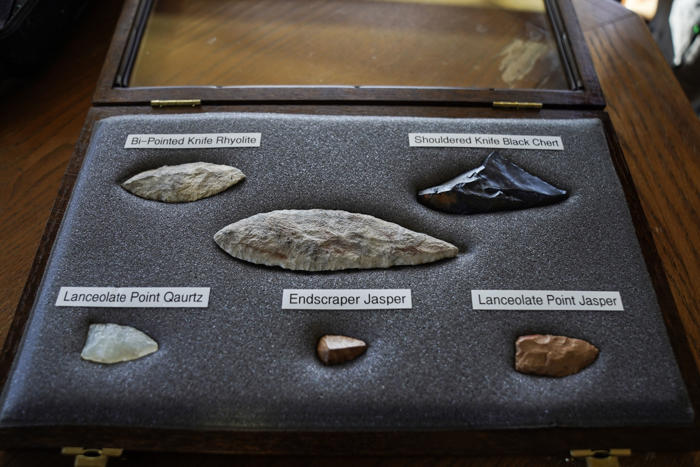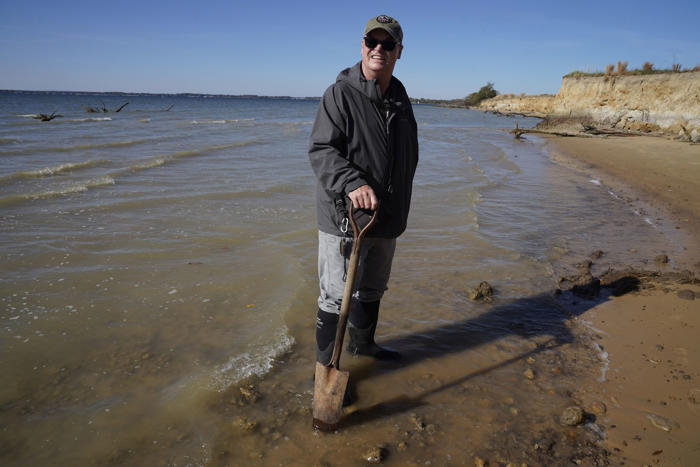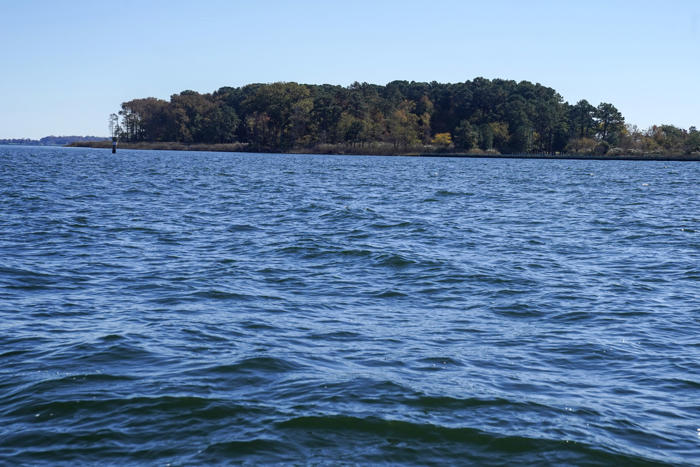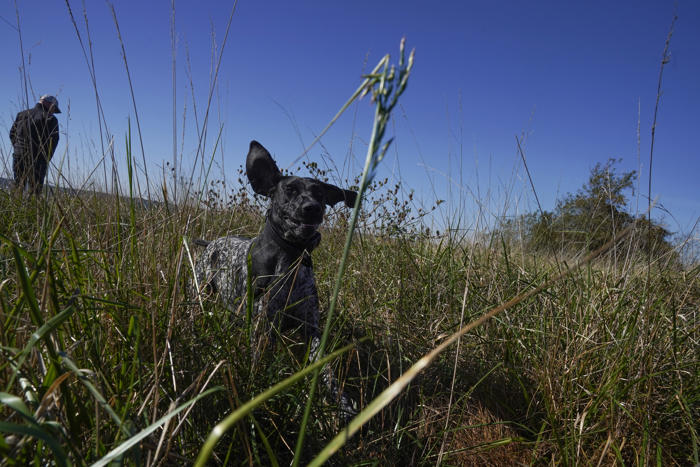Ancient Chesapeake site challenges timeline of humans in the Americas
PARSONS ISLAND, Md. — With the Chesapeake Bay sloshing at his knee-high boots, Darrin Lowery stood back and squinted at a 10-foot-tall bluff rising above a narrow strip of beach. To the untrained eye, this wall of sandy sediment is the unremarkable edge of a modest island southeast of the Bay Bridge.
To Lowery, a coastal geologist, its crumbling layers put the island at the center of one of the most contentious battles in archaeology: when and how humans first made their way into the Americas.
The story of the first Americans has long been a matter of public and scientific fascination, undergirded at times by vicious disagreements. The timeline of when people arrived has shifted earlier in grudging steps over the past century, and scientists today mostly agree people were in the Americas at least 15,000 years ago.
Lowery’s site and others like it could revise the story again, pushing back the timeline earlier than most experts thought possible. In total, Lowery and a motley crew of collaborators have discovered 286 artifacts from the site on the island’s southwestern edge. The oldest, they reported, was embedded with charcoal dated to more than 22,000 years ago, a time when much of the continent would have been covered in ice sheets.
If Lowery is right, Parsons Island could rewrite American prehistory, opening up a host of new puzzles: How did those people get here? How many waves of early migration were there? And are these mysterious people the ancestors of Native Americans?

Ancient Chesapeake site challenges timeline of humans in the Americas
New claims of sites dated this far back face a wall of skepticism, rooted in legitimate scientific scrutiny and in the threat they pose to long-entrenched views.
To complicate matters, Lowery — who has been affiliated with the Smithsonian but does much of his work independently — presented the results of his study of Parsons Island in a 260-page manuscript posted online rather than in a traditional peer-reviewed journal.
The peer-review process is designed to help validate scientific claims, but Lowery argues that in archaeology it often leads to a circle-the-wagon mentality, allowing scientists to wave away evidence that doesn’t support the dominant paradigm. He says he isn’t seeking formal publishing routes because “life’s too short,” comparing this aspect of academic science to “the dumbest game I’ve ever played.”
The island is also a challenging site to study for a variety of reasons — most poignantly because it is rapidly eroding as the land subsides and sea level rises. The spot where the artifacts were found is now covered by the choppy waters of the bay.
“The visit reinforced my will to invest my time into this time period, because it’s a very fragile record,” said Sebastien Lacombe, an archaeologist at Binghamton University, who visited the island in 2017. “It’s at risk of disappearing, and we’re at risk of [allowing] these sites and artifacts to lose their meaning forever.”
‘A weirdo kid’

Darrin Lowery walks a beach on Parsons Island. Most of the artifacts were excavated by erosion, discovered on the beach after they had already fallen out of the bluff.
Lowery began exploring the Chesapeake shoreline as a child, wandering his backyard on Tilghman Island, about 15 miles southwest from Parsons Island.
In 1977, 9-year-old Lowery picked up a distinctive fluted stone projectile point. A few years later, he saw something similar on a documentary on public television, in which a Smithsonian archaeologist explained it was a Clovis point, a relic of what most people then believed were the first Americans.
For the last half of the 20th century, the peopling of the Americas followed a tidy narrative. Humans traveled from Siberia across a land bridge that connected Asia and North America during the last Ice Age, when sea levels dropped. They then migrated southward around 13,000 years ago, when the ice sheets covering the continent retreated and exposed a previously impassable inland route. These people — named after a site in Clovis, N.M. — left behind distinctive, fluted stone points that have since been found scattered across North America.
Lowery turned to his dad and said, “I found one of those.”
He found more by walking the shoreline every day. Lowery made discoveries as he meandered, and he began to understand how seasonal patterns, sediment movement, wind and waves could unearth ancient treasures.
“I was a weirdo kid,” he recalled.
He trained as a geologist, and it was geology that initially attracted Lowery to study Parsons Island.
In 2010, he published an article in Quaternary Science Reviews describing layers of windblown silt deposited between 13,000 and 41,000 years ago at Miles Point in eastern Maryland. But the geological record is like reading the CliffsNotes version of a book, and he was frustrated by an “unconformity” in the sediment layers where thousands of years were missing, like someone had ripped out those chapters.

Parsons Island is rapidly eroding. The archaeological site is now covered by the Chesapeake Bay.
Lowery and a colleague were prowling around in a whaler, looking for a spot that might fill in the blanks, when they spotted a black streak of sediment rising up out of the bay. They pulled up to Parsons Island and thought they had found “the Rosetta stone” to decode the geology.
Parsons is a 78-acre island less than a mile offshore that is privately owned by the Corckran family, which uses it as a family retreat. With the Corckrans’ permission, Lowery and colleagues began to visit regularly. The bluff layers preserved a remarkably intact geologic timeline going back more than 40,000 years.
Then, one morning in August 2013, the team discovered a leaf-shaped prehistoric stone tool jutting out of this crumbling wall. They knew from the work they’d already done that it was probably quite old.
On a recent visit to the island, geoarchaeologist Daniel Wagner demonstrated why. He stepped back to scan the cliff, then tapped a narrow spade into a light tan sediment layer just above his head. That, he said, is the geologic “chapter” where they’d expect to find Clovis artifacts. Lower layers were set down before Clovis.
The palm-size tool Lowery and his colleague found came out of the dark sediment layer near their knees.
The scientists used two methods to date the sediment around the artifact, both showing it was more than 20,000 years old. They scoured the beach on 93 visits and conducted a formal, top-down excavation, collecting the 286 artifacts. They sent out sediment to labs that specialize in studying ancient pollen and microfossils called phytoliths to help reconstruct the ecosystem at the time.
Back then, this region wouldn’t have been a coastline. The sediment the tools are embedded in dates to the “last glacial maximum” — the scientific term for the most recent coldest period of the Ice Age. In the final analysis, Lowery thinks the artifacts may have been transported downslope before they were buried, making them between 15,000 and 20,500 years old.
“This was a swale, where water was collecting,” Lowery said, envisioning the ancient landscape. “You’ve got a dune. It’s got sedges and small trees on it that are windblown and all contorted, and then behind it you’ve got a little pond.”
That pond may have attracted prehistoric bison, musk ox and llamas, whose fossilized molars he’s found scattered on the island shore. And it may have been what attracted the mysterious people who left behind a cache of stone tools.
A story in flux

Parsons Island is seen from nearby Kent Island in the Chesapeake Bay.
Parsons Island is the latest addition to a growing list of what are called pre-Clovis sites. But while the long-held “Clovis First” theory has crumbled over the past three decades, that has only deepened the debate about how much earlier the first Americans arrived.
Claims of early sites present a challenge on two fronts. The first is technical: Dating a site convincingly can be difficult, depending on the context. Sediments can shift or be disturbed. What at first look like artifacts can turn out to be “geofacts,” created not by humans but by natural processes or animals.
As a result, many pre-Clovis sites “enjoy a Warhol-esque 15 minutes of fame, and then they disappear” because of real problems with the geology or the methods, said archaeologist James Adovasio. In 1973, he began excavating Meadowcroft Rockshelter in Pennsylvania, which dated back 16,000 years. It was instantly mired in controversy, and the site still has its critics today.
The second challenge reflects the culture of science. For a long time, people who claimed to find pre-Clovis sites were swimming upstream against deeply entrenched thinking. Tom Dillehay, an archaeologist at Vanderbilt University, began working on a site in southern Chile called Monte Verde in 1977, which was dated to 14,500 years ago. He recalled a group of researchers he calls the “Clovis police,” scientific gatekeepers who summarily rejected any pre-Clovis sites, sometimes for valid reasons and sometimes as a knee-jerk reaction.
Monte Verde began to change that. In 1997, a group of respected archaeologists visited the site and declared it authentic.
“It took about 25 to 30 years for Monte Verde to be accepted,” Dillehay said. “We went through hell.”

Holly, a German shorthaired pointer, runs across a bluff top on Parsons Island.
Lowery says he isn’t interested in running that gantlet. He noted that he drew on multiple labs and methods for dating the Parsons Island artifacts in an effort to ensure that any one extremely old date isn’t a fluke. He’s also invited other researchers in to visit and study the site.
That approach irritates some scientists. David Meltzer, an archaeologist at Southern Methodist University, said in an email that he would not discuss Lowery’s claims “until they go through the wringer of peer review and get published.”
Others like Stuart Fiedel, an independent archaeologist based in western Massachusetts who has been skeptical of other sites, say the site should not fly under the radar just because of Lowery’s unconventional process.
“There are people I know in the field who will not pay any attention to it, because it has not been peer-reviewed, which I think is kind of sticking your head in the sand,” Fiedel said. “It’s there. We can’t act as [if] nothing’s been found there.”
A bigger issue may be the site’s rapid erosion. Most of the artifacts were found after they’d fallen out of the bluff, which means their place in the geologic timeline is obscured. Nine artifacts were found in place, and only three were able to be dated using charcoal flecks found next to them.
Steven Forman, a geoscientist at Baylor University, helped date the sediment layers at Parsons Island, corroborating findings from another lab. He said that it’s hard to find the artifacts in the kind of bulletproof geological context needed to support extraordinary claims.
“The case is not as tight as we like to see it with other sites,” Forman said.
Michael Waters, an archaeologist at Texas A&M University who has worked on pre-Clovis sites and excavated at Parsons Island, thinks he probably got there too late, when most of the artifacts had already been eroded out. Still, he pays someone to monitor the bank profile on a regular basis, because he’s ready to jump on a plane if they see something in place.
“Too bad we didn’t get there four to five years sooner,” Waters said.
Enter ancient DNA

An ancient bovine tooth is among the fossils found so far on Parsons Island.
Parsons Island isn’t the only site that could dramatically push back human arrival in the Americas. Last fall, a study published in the journal Science described fossilized human footprints discovered at White Sands National Park in New Mexico that have been dated to between 21,000 and 23,000 years ago. That stunning finding suggests people were here during the Ice Age — much earlier than most experts thought possible if the first humans arrived via the Bering land bridge and inland corridor.
The dates at White Sands are still being disputed because of questions about the methods. But the timeline collides head-on with another exciting line of evidence: studies of ancient DNA.
By examining genetic material preserved in bones and teeth and comparing those samples to modern populations, scientists have been able to track when populations mingled and became isolated from one another, offering a new window into patterns of human migration.
In broad strokes, they’ve found that the ancestors of Native Americans split from ancient Siberian populations no earlier than 23,000 years ago. The studies can’t say where such splits took place, but many scientists interpret genetic evidence to mean that the ancestors of modern people weren’t in the Americas until much later.
Genetic studies suggest that Native American ancestors traveled into what is now the United States between 17,500 and 14,600 years ago.
Joe Watkins, a senior consultant for Archaeological and Cultural Education Consultants in Tucson and a Choctaw tribal member, said that he sees a few problems with using the still-evolving DNA evidence to decide how ancient sites are related to modern-day people.
“The reality is genetics does not equal culture,” Watkins said. He also argued that there are still too few samples of ancient DNA in the Americas to be sure they capture the whole story.
“Trying to create population histories based on 10 people, if you will, is a little bit of a scientific conundrum,” Watkins said.
It could be that additional ancient genomes will one day help fill in the blanks. Another possibility is that earlier sites could represent small, isolated groups of people who didn’t contribute to the ancestry of living Native Americans.
“Let’s suppose you have a successful population colonizing an area, and then one day, 15 males go out and get eaten by a short-faced bear,” Lowery said. “You reduce the genetic diversity, and bada boom, bada bing, game over.”
All this explodes the neat picture of one population migrating into the Americas as ice sheets retreated, hunting big animals like mammoths and giant sloths, driving them into extinction as they went. If there were small groups making their way into the New World, with different stone tool technologies, and far earlier than previously believed, how did they get here?
People could have migrated along the coast by boat, following a “kelp highway.” It’s also possible the ice sheet was not as impenetrable as experts have long thought. Lowery’s longtime collaborator, Dennis Stanford, proposed that people crossed the Atlantic Ocean in what is known as the Solutrean Hypothesis, though that idea has been rejected by many archaeologists.
To resolve the question, scientists need to keep looking for more evidence. Archaeology is a historical science, and unlike chemistry or biomedicine, where researchers can perform the same experiment over and over again to see if they get the same results, consensus is built by argument, counterargument and new evidence.
To a certain extent, older ideas and prejudices also fall away as new people enter the field, said James Feathers, who performed dating on samples from Parsons Island before he retired from the University of Washington.
“Sometimes you have to wait for people to die off,” Feathers said.

Alex Corckran, whose family owns Parsons Island, stands on a beach on the southern side of the island.
Lowery is determined to keep motoring around the Chesapeake, researching the ephemeral landscape that he loves and that may contain clues about human prehistory. He acknowledges that the sites, perhaps a little bit like him, are “persnickety” but that shouldn’t deter interest in them. Instead, it should spur more.
He noted that if a pod of silverfish was found gnawing on documents in the National Archives, people would be galvanized to act.
“I view it as my swan song,” Lowery said, “to say you can learn a lot from [an] eroding site if you do a little bit of effort and look at it systematically.”
